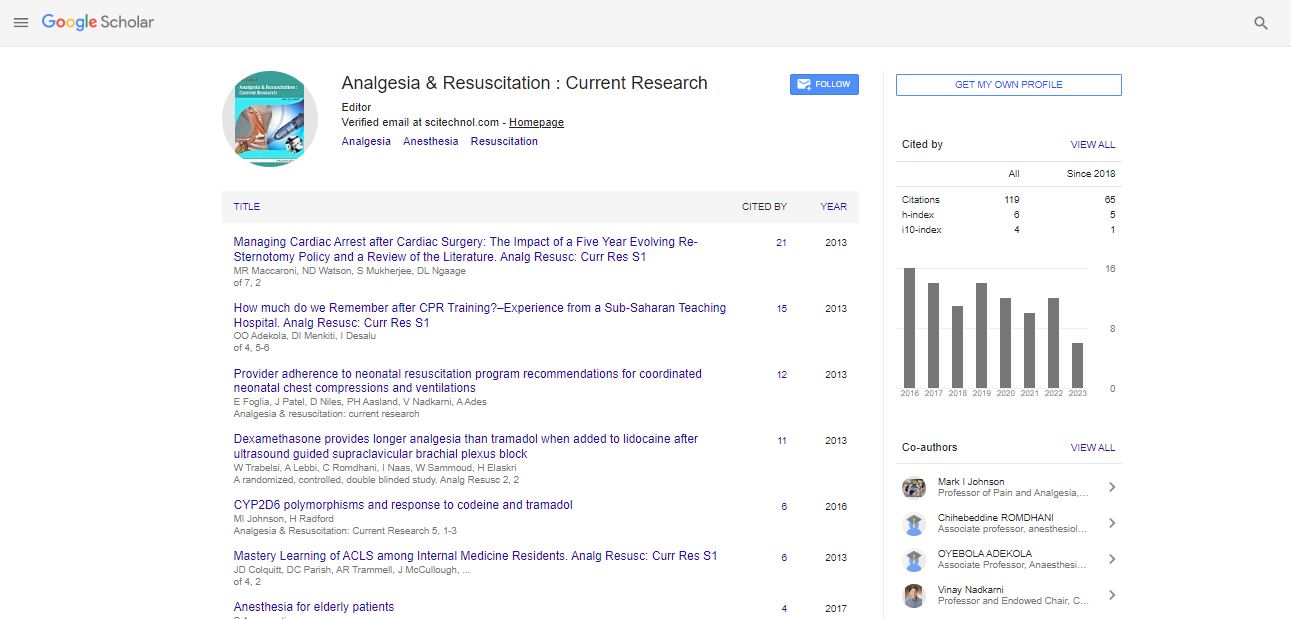Commentary, Analg Resusc Curr Res Vol: 12 Issue: 4
Relationship between Sedatives and Reduced Reactions to External Factors
Alexandre Nguyen*
1Department of Anesthesia, University of Thessaloniki, Thessaloniki, Greece
*Corresponding Author: Alexandre Nguyen,
Department of Anesthesia,
University of Thessaloniki, Thessaloniki, Greece
E-mail: nyugen@alex.gr
Received date: 22 November, 2023, Manuscript No. ARCR-24-128176;
Editor assigned date: 24 November, 2023, PreQC No. ARCR-24-128176 (PQ);
Reviewed date: 08 December, 2023, QC No. ARCR-24-128176;
Revised date: 15 December, 2023, Manuscript No ARCR-24-128176 (R);
Published date: 22 December, 2023, DOI: 10.4172/2324-903X.1000133.
Citation: Nguyen A (2023) Relationship between Sedatives and Reduced Reactions to External Factors. Analg Resusc: Curr Res 12:4.
Description
Sedation, defined as the reduction of an individual's response to external stimuli, plays a crucial role in the field of medicine. It is a state induced by sedative substances that aim to alleviate anxiety, depression, irritability, excitement, stress, and other related conditions. This essay delves into the intricate relationship between sedatives and the subsequent reduction in reactions to external factors, providing insights into the physiological and psychological mechanisms at play. At its core, sedation involves modifying the central nervous system's activity to induce a state of calmness and relaxation. Sedatives act on neurotransmitters, such as Gamma-Aminobutyric Acid (GABA), to suppress neural activity, resulting in diminished responses to external stimuli. This reduction is not limited to a single aspect but encompasses a spectrum of reactions, including emotional responses and stress-related reactions. One of the primary realms where the impact of sedatives is observed is in emotional responses. Anxiety and depression, common manifestations of stress, are significantly influenced by the administration of sedatives. Medications targeting the GABAergic system, like benzodiazepines, contribute to a reduction in anxious thoughts and depressive symptoms. By modulating neurotransmitter activity, sedatives create a more tranquil mental state, thereby lessening the emotional response to external stressors.
Sedatives also prove effective in attenuating irritability and excitement. Individuals experiencing heightened states of arousal may find relief through sedation, as these medications dampen excessive neural activity. This reduction in excitability extends to scenarios where irritability is a response to external factors. Sedatives offer a calming effect, mitigating the intensity of reactions that might otherwise be exacerbated by environmental stimuli. Stress, a pervasive aspect of modern life, is intricately linked to an array of physiological and psychological responses. Sedation acts as a valuable tool in managing stress by reducing the physiological arousal associated with it. Cortisol, the stress hormone, sees a decline under sedative influence, reflecting a downregulation of the body's stress response. Consequently, sedation not only addresses the psychological aspects of stress but also has a tangible impact on the physiological markers of stress.
The interplay between sedatives and reduced reactions to external factors is not solely confined to psychological processes. The physiological mechanisms underlying sedation further illustrate the intricate relationship. GABA, the major inhibitory neurotransmitter, assumes a central role in sedation. Sedatives enhance GABAergic activity, hyperpolarizing neurons and reducing their responsiveness to external stimuli. This physiological modulation contributes to the overall sedative effect on the central nervous system. It is essential to recognize that individuals exhibit variability in their responses to sedatives. Factors such as age, health status, and genetic predispositions can influence the efficacy and side effects of sedative medications. Understanding these variations is crucial for tailoring sedation strategies to meet individual needs while minimizing adverse effects.
In conclusion, the relationship between sedatives and reduced reactions to external factors is a multifaceted interplay of physiological and psychological processes. Sedation, through its impact on neurotransmitter systems and neural activity, offers a valuable means of managing emotional responses, irritability, excitement, and stress. The intricate mechanisms underscore the importance of understanding of sedation in clinical settings. As research advances, further insights into the specific interactions between sedatives and reactions to external factors will continue to shape the landscape of pharmacological interventions aimed at promoting mental well-being.
 Spanish
Spanish  Chinese
Chinese  Russian
Russian  German
German  French
French  Japanese
Japanese  Portuguese
Portuguese  Hindi
Hindi 
